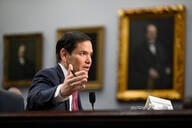You have /5 articles left.
Sign up for a free account or log in.

Howard University
For decades, and really for as long as historically Black colleges and universities have existed, those running and doing research at the institutions have been angered that the deck has been stacked against their getting federal grants to do research.
Far more of the $100 billion-plus federal agencies give higher education in research and development grants tend to go to the big -- predominantly white -- institutions.
When Ivory Toldson, who’d been executive director of the White House Initiative on Historically Black Colleges and Universities in the Obama administration, examined the disparity in 2016, he noted this: in 2014 Johns Hopkins University received $1.6 billion in federal, state and local grants and contracts, more than the $1.2 billion all of the nation’s HBCUs, combined, received that year.
But there’s growing optimism the long-standing disparity may change. Little noticed during the campaign was a pledge by President-elect Joe Biden to take on the issue. And as he prepares to take office at a time when the nation is confronting systemic racism, his vice president will be Kamala Harris, the first graduate of a historically Black university in the position. A member of his transition’s advisory team, Tony Allen, is president of Delaware State University, an HBCU, with a long relationship with Biden -- he was Biden’s speechwriter in the Senate.
Biden, in the higher education plan he released during the campaign, included spending $20 billion to help HBCUs and other minority-serving institutions catch up on having the state-of-the-art research facilities they need to compete with the larger institutions, as well as another $10 billion to create centers of excellence at colleges whose main focus is on educating students of color. Biden pledged, as well, to require his agencies to examine whether there has been a disparity in the amount of grants and contracts they’ve given HBCUs and other institutions serving minorities, and then to fix it.
The long-standing complaint was raised by HBCU presidents about three weeks ago during a videoconference call with Harris, said Harry Williams, president and CEO of the Thurgood Marshall College Fund, which organized the call with the United Negro College Fund.
“One of the things that came up was whether the administration could make it possible for our institutions to be able to compete for and receive some of the large research grants that typically hasn’t come our way,” Williams said in an interview.
Harris, he said, “gave a strong verbal statement of support.”
“What you see in Vice President-elect Harris is a prime example of what’s offered by HBCUs,” said Alabama State University president Quinton Ross, who was on the call. “The opportunity for individuals to grow and prosper all the way to becoming vice president of the United States.
“She’s strong in her stance supporting HBCUs because she knows what HBCUs did for her,” he said.
Spokespeople for Biden’s transition team didn’t respond to inquiries last week. But his campaign’s national policy director, Stef Feldman, pledged support for HBCUs amid the national reckoning with systemic racism during a call with members of the Education Writers Association last month.
“One of the driving factors for Vice President Biden doing that is recognizing that in order to meet the challenges of the moment, we need to be tapping in to the talent at our historically Black colleges and universities and minority-serving institutions,” she told education reporters, “which is why some of that funding will go to setting up research hubs and incubators at those schools.”
To be sure, HBCU lobbyists said whether billions of dollars will flow to the institutions will depend on Congress. Some of the ideas Biden laid out have been discussed before, they have always fallen away, Sandra Harris-Hooker, vice president of the Morehouse School of Medicine and its executive vice dean for research and academic administration, said in an interview. But she was encouraged about the prominence of the proposal in Biden’s overall plan.
“What [Biden] had done is to elevate it to such a robust agenda. We’re extremely excited to have a champion, which is what is needed to move the needle,” Harris-Hooker said.
“This is truly a celebratory moment in the journey of HBCUs,” Bruce Jones, Howard University’s vice president of research, said in an interview.
Toldson, now a Howard professor in human development and psychoeducational studies, examined how little of the federal government’s research dollars go to HBCUs in a series of reports he wrote at the White House.
HBCUs, for instance, received less than 1 percent of the $18.4 billion the Department of Health and Human Services gave out in 2014, and only 1.7 percent of the more than $5 billion the National Science Foundation awarded to institutions that year.
No HBCU is on the list of the top 30 institutions receiving federal research and development dollars between 2016 and 2018, according to a report last year by the National Science Foundation, noted David Sheppard, the Thurgood Marshall College Fund’s chief legal officer and chief of staff.
The reasons are multifaceted and self-perpetuating, HBCU leaders said in interviews. And it begins with a history of racism that has underfunded the minority-serving institutions.
Throughout the history of higher education in America, far more dollars have gone to some institutions, which has helped them become major research institutions today, while HBCUs have lagged behind.
“It’s intertwined with the history of race in America and the views of the level and types of education that African Americans receive and are entitled to,” said Jones, of Howard University. While what are now prominent research institutions prospered from a boom in higher education spending in the 1950s, HBCUs were left behind. And they’ve never caught up. “Much of what happens today is because of what happened yesterday,” he said.
As agencies award grants and contracts, it’s not a surprise that institutions like Johns Hopkins that’ve been able to assemble the most state-of-the-art equipment have an advantage getting the money.
Toldson in his 2016 paper noted as well that institutions getting the most in grants also have more to spend on getting more grants. Even the HBCUs most successful at getting federal research dollars get only a fraction of the average amounts received by institutions where more of the students are white.
The Morehouse School of Medicine, which received $85 million from the federal government in 2014, was awarded the most in federal, state and local government funding among HBCUs that year, he wrote. Even so, that was only half of the average $165 million that all 47 Carnegie-classified medical colleges received that year, according to Toldson.
Federal agencies in recent years have been making an attempt to have more racial diversity on the boards that review grant applications, Harris-Hooker said. Still, studies still raise questions about whether boards still have a bias against HBCUs. While not overtly racist, she said the boards can give preference to the institutions they’ve awarded grants to in the past.
But what that misses, she said, is that HBCUs like Morehouse medical school, which is not affiliated with Morehouse College, can bring their own expertise, like the health issues affecting people in the low-income urban and rural areas the medical school’s researchers often work with.
Biden, according to his higher education plan, would try to create more equity in research funding through a number of measures, some of which would involve the support of Congress, and others that the administration could do on its own.
As part of the $70 billion Biden said he wants to steer to HBCUs, he pledged to invest $20 billion to build research facilities and labs, as well as to update deteriorating facilities at the institutions, including those serving other minority groups. He’d spend another $10 billion to create 200 new centers of excellence that would be research incubators in areas like climate change, globalization, inequality, health disparities and cancer.
In addition, he would require that 10 percent of federal research grants to universities with endowments greater than $1 billion be spent to subcontract with an HBCU or other minority-serving institutions, including tribal campuses. According to the National Association of College and University Business Officers, 112 institutions, ranging from Harvard University’s $38.3 billion to the University of Miami’s $1.02 billion, had endowments of $1 billion or more last year.
Singling out universities with the largest endowments has been a sensitive issue, including President Trump and Education Secretary Betsy DeVos’s call for institutions with large endowments to turn down their share of the coronavirus relief funding Congress gave colleges and universities in the CARES Act earlier this year.
Large research associations are likely to oppose the requirement to spread the wealth with HBCUs.
“First and foremost, federal grant funding for research should be based solely on the merit of the research being conducted and its ultimate benefit to the American people. Tying endowments to grant funding is linking apples to oranges,” said Pedro Ribeiro, spokesman for the Association of American Universities.
“Endowments are charitable contributions made to institutions to support a wide variety of things, including scholarships and other student aid. The government should not be putting policies in place that reduce support for scholarships and student aid,” he said.
However, AAU president Barbara Snyder said in a statement the group does support increasing the research capability at HBCUs. “We don’t disagree with the Biden/Harris view here,” she said. Rather than a requirement on large research institutions to share their grant dollars with HBCUs, Snyder said the association recommended to both the Biden and Trump campaigns that whoever wins should create more partnerships between leading research universities and HBCUs, as well as other institutions serving minorities. The partnerships would help HBCUs and other minority-serving institutions compete for grants, the association wrote in letters to the campaigns.
Partnerships with larger institutions can be helpful, Jones said. “But my preference for Howard University is to be the prime recipient of the grants.”
In addition, Biden’s proposal calls for HBCUs and other institutions serving minorities to compete against each other for competitive grants, instead of having to go up against bigger institutions.
“They’re already so ahead in the game,” Williams, of the Thurgood Marshall fund, said. “We don’t have the same resources. We don’t have the same connections.”
Lobbyists for HBCUs said it’s unclear if such a requirement would require legislation from Congress, but Biden would need congressional support to send the minority institutions billions of dollars.
“There’s too many things in play” to know how much funding Congress could provide, Sheppard said, including the result of two runoff elections in Georgia in January that will determine control of the Senate.
Lodriguez Murray, the United Negro College Fund’s vice president of public policy and government affairs, said he’s “cautiously optimistic” the Biden administration will follow through. “There is no doubt having HBCU graduate Sen. Harris as Vice President is huge, but I want to see how this White House completely demonstrates dismantling structural racism by having organizations like UNCF truly and fully at the table -- and taking us seriously,” he said in an email.
He noted that HBCUs have lost two important supporters in the Senate with Harris’s election to vice president and after Senator Doug Jones, a Democrat from Alabama, lost his re-election bid.
“HBCUs need more champions -- especially from the Deep South senators where our institutions are located,” he said.
Republican aides, including a spokesman for education committee chairman Senator Lamar Alexander, declined comment last week. Republicans likely would support the proposals in principle, but they could balk at the price tag, said Frederick Hess, director of education policy for the conservative American Enterprise Institute.
“There’s absolutely room to do deals on this,” he said. Hess noted that according to exit polls, support by Black voters for Trump increased slightly over 2016. “There’s a bunch of Republicans who want to run [for president] in 2024 -- [Marco] Rubio, Josh Hawley, Mike Lee -- who’d want to grow that coalition.”
But, he said, “the numbers Biden is floating are huge. There’s a whole lot of things the Biden campaign promised to do, whether it’s climate change, or K-12 education. I don’t know how he’s going to make all these numbers work.”
Still, Williams said funding to grow their institutions would help HBCUs compete for grants with larger institutions, just as institutions like Johns Hopkins have grown over time.
“Johns Hopkins wasn’t always Johns Hopkins,” he said.
Harris-Hooker argued the funding would help people find work -- a priority of both parties during the recession. “Part of this is workforce development,” she said.
While the prospects for massive funding are unsure, Biden could take some actions without congressional approval. Another component of this plan would require agencies to examine whether they discriminate against HBCUs and other minority-serving institutions and, if so, show improvement each year.
The issue is important to the institutions that rely on tuition without research funding or as much in endowments as other colleges, Sheppard said. Additional research dollars “would let our institutions be more resilient to downturns on the economy, whether it be the pandemic or other events. It would give us the ability to supplement the revenue institutions get from tuition,” he said.
“The goal at the end of the day is to level the playing field so that our students have the same opportunities as students who attend predominantly white institutions,” Sheppard said.
“When our students go to the lab,” Williams said, “I want them to have the same equipment as at the research universities.”




